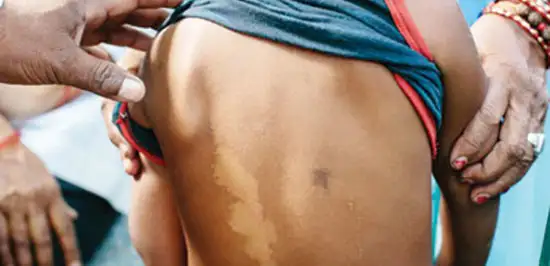Blitz Bureau
NEW DELHI: Leprosy, or Hansen’s disease, is a chronic infectious disease caused by bacteria mycobacterium leprae. Infection can lead to involvement of the nerves, respiratory tract, skin, and eyes. The disease is feared because it can lead to deformity; this is also the cause of the social stigma traditionally attached to it.
The introduction of multidrug therapy (MDT) in 1983 in India revolutionised treatment of leprosy. MDT treatment has been provided free of cost to patients through WHO. Early diagnosis and treatment with MDT can prevent disabilities and deformities. Since the introduction of MDT, the incidence and prevalence of the disease has remarkably decreased.
Historical facts
Decennial population census of 1951 reported 13,74,000 cases and a prevalence rate of 38.1 per 10,000 population. The Government recognised leprosy as a national health problem, and launched the National Leprosy Control Programme in 1954-55. The programme gained momentum during the Fourth Five-Year Plan period (1969- 1974) after it was made a Centrallysponsored programme, thus receiving the necessary priority and funding. To achieve this increased coverage, the involvement of NGOs was strengthened, and health education programmes became a prominent component of the leprosy programme.
The Government also encouraged the involvement of NGOs in SET (Survey Education and Treatment) activities in allotted areas through a scheme introduced in 1983. SET centers were set up in moderate/low endemic areas and urban leprosy centers in urban areas. T The leprosy programme provided free domiciliary treatment in endemic districts through specially trained staff in fixed leprosy control units; and in moderate to low endemic districts, through mobile leprosy treatment units. Cases were treated at monthly leprosy clinics held at a fixed point in the village. This led to improved compliance and provided an opportunity for counselling each patient.
Definitive cure
In 1982, the definitive cure for leprosy with Multi Drug Therapy (MDT) containing this bactericidal drug Rifampicin and bacteriostatic drug clofazimine besides dapsone was endorsed by WHO as the standard leprosy treatment regimen. In 1983 the introduction of MDT regimens marked the beginning of the National Leprosy Eradication Programme (NLEP).
The NLEP is a Centrally-sponsored scheme under the National Health Mission (NHM). Funds are allocated to states and UTs based on state/UT specific programme implementation plans, with a focus on local needs, priorities, and capacity. Introduction of MDT, strong political commitment, decentralised implementation, and a robust Information, education, and communication strategy brought about tremendous success in leprosy control.
In 1981 the leprosy prevalence rate that was 57.2 /10,000 was reduced to 44.8 by March 1984 and to 2.4 per 10,000 population by March 2004. The rate of Grade II deformity (visible deformities) among new patients in 1981 was 20 percent; and by 2004, it was only 1.5 percent.
Elimination goal
In March 2004, 17 states and 250 districts had achieved the goal of leprosy elimination (defined as a prevalence rate of less than one per 10,000 population) and seven states were close to the goal. With determined campaigns to search for early leprosy cases, there has been a drastic reduction in the number of cases exhibiting these forms of the disease.
The goal of bringing the deformity rate down to less than 2 per cent by the end of the current World Banksupported project (2001-04) had been achieved. India as a whole achieved the goal of national elimination of leprosy by December 2005.
































